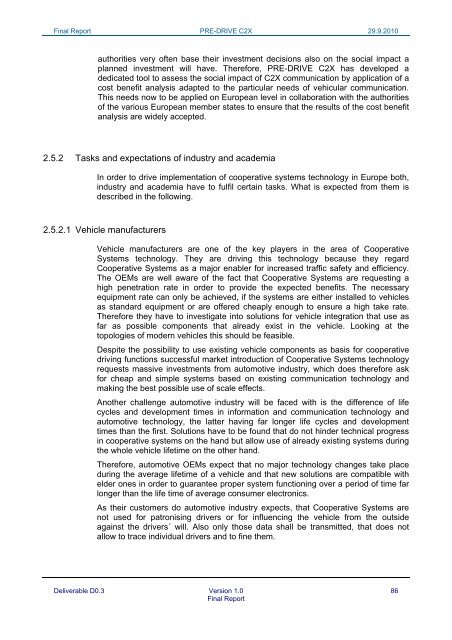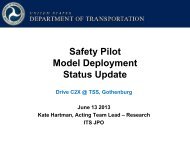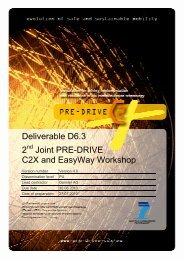PRE-DRIVE C2X Deliverable D0.3 Final report_20100929.pdf
PRE-DRIVE C2X Deliverable D0.3 Final report_20100929.pdf
PRE-DRIVE C2X Deliverable D0.3 Final report_20100929.pdf
Create successful ePaper yourself
Turn your PDF publications into a flip-book with our unique Google optimized e-Paper software.
<strong>Final</strong> Report <strong>PRE</strong>-<strong>DRIVE</strong> <strong>C2X</strong> 29.9.2010<br />
authorities very often base their investment decisions also on the social impact a<br />
planned investment will have. Therefore, <strong>PRE</strong>-<strong>DRIVE</strong> <strong>C2X</strong> has developed a<br />
dedicated tool to assess the social impact of <strong>C2X</strong> communication by application of a<br />
cost benefit analysis adapted to the particular needs of vehicular communication.<br />
This needs now to be applied on European level in collaboration with the authorities<br />
of the various European member states to ensure that the results of the cost benefit<br />
analysis are widely accepted.<br />
2.5.2 Tasks and expectations of industry and academia<br />
In order to drive implementation of cooperative systems technology in Europe both,<br />
industry and academia have to fulfil certain tasks. What is expected from them is<br />
described in the following.<br />
2.5.2.1 Vehicle manufacturers<br />
Vehicle manufacturers are one of the key players in the area of Cooperative<br />
Systems technology. They are driving this technology because they regard<br />
Cooperative Systems as a major enabler for increased traffic safety and efficiency.<br />
The OEMs are well aware of the fact that Cooperative Systems are requesting a<br />
high penetration rate in order to provide the expected benefits. The necessary<br />
equipment rate can only be achieved, if the systems are either installed to vehicles<br />
as standard equipment or are offered cheaply enough to ensure a high take rate.<br />
Therefore they have to investigate into solutions for vehicle integration that use as<br />
far as possible components that already exist in the vehicle. Looking at the<br />
topologies of modern vehicles this should be feasible.<br />
Despite the possibility to use existing vehicle components as basis for cooperative<br />
driving functions successful market introduction of Cooperative Systems technology<br />
requests massive investments from automotive industry, which does therefore ask<br />
for cheap and simple systems based on existing communication technology and<br />
making the best possible use of scale effects.<br />
Another challenge automotive industry will be faced with is the difference of life<br />
cycles and development times in information and communication technology and<br />
automotive technology, the latter having far longer life cycles and development<br />
times than the first. Solutions have to be found that do not hinder technical progress<br />
in cooperative systems on the hand but allow use of already existing systems during<br />
the whole vehicle lifetime on the other hand.<br />
Therefore, automotive OEMs expect that no major technology changes take place<br />
during the average lifetime of a vehicle and that new solutions are compatible with<br />
elder ones in order to guarantee proper system functioning over a period of time far<br />
longer than the life time of average consumer electronics.<br />
As their customers do automotive industry expects, that Cooperative Systems are<br />
not used for patronising drivers or for influencing the vehicle from the outside<br />
against the drivers´ will. Also only those data shall be transmitted, that does not<br />
allow to trace individual drivers and to fine them.<br />
<strong>Deliverable</strong> <strong>D0.3</strong> Version 1.0 86<br />
<strong>Final</strong> Report







